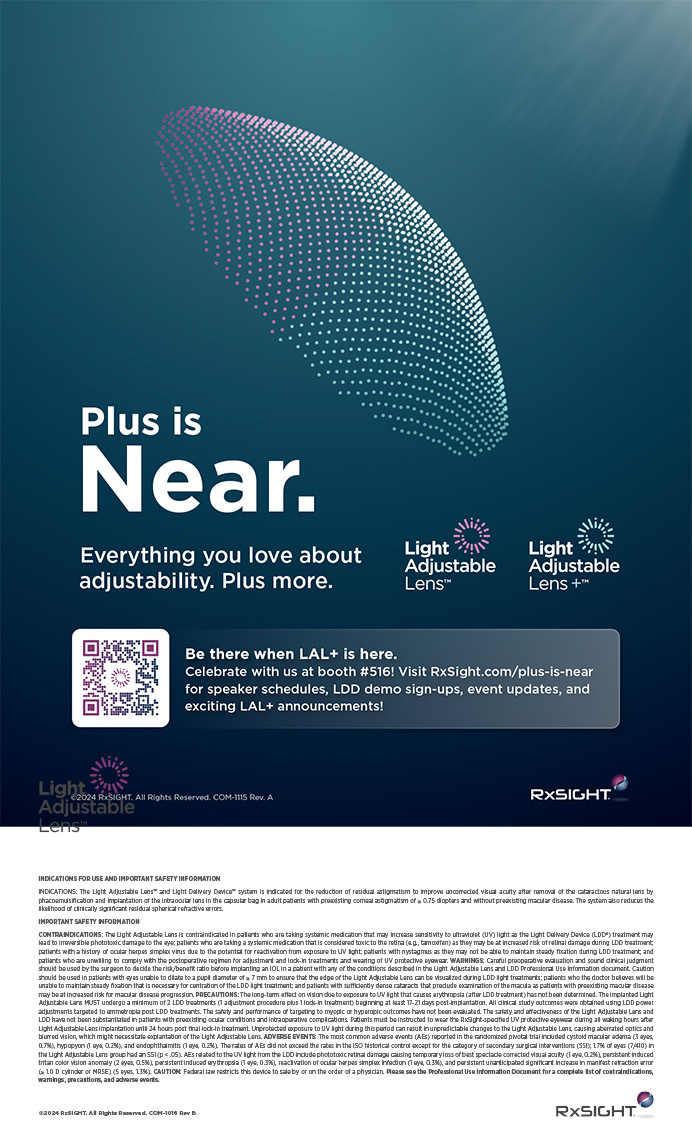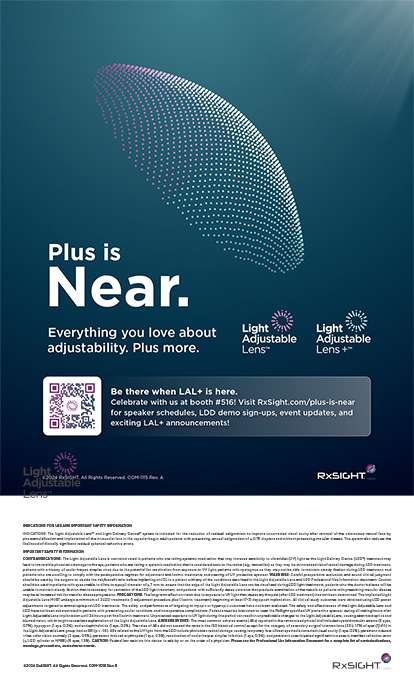
Cataract surgery in the modern era includes an effort to achieve refractive goals, and our patients desire the best vision possible. I discuss the potential for presbyopia correction with every cataract or lens replacement patient—including those who are not even candidates for these lenses—so that no patient might later feel that he or she was not properly informed. I do not, however, use the word premium, as I think this labeling can be misleading.
Yes, presbyopia correction is above and beyond the standard of removing the cataract and implanting an IOL to avoid aphakia and hyperopia. As such, it is a refractive, nonmedical, elective service. However, the word premium can invoke a luxury connotation that is inconsistent with the reality that this is our best attempt with current technology to restore natural visual function. Presbyopia-correcting IOLs are not perfect.
SETTING EXPECTATIONS
The old adage states that the only way to completely avoid complications is to completely avoid operating, and this same wisdom applies to patient satisfaction. Even surgeons with perfect preoperative screening, the best patient communication, and excellent surgical techniques will occasionally have unhappy patients, including patients with modern extended depth of focus (EDOF) or multifocal lens designs. Determining the reason for unhappiness is crucial because some of the causes can likely be addressed. Typically, patient unhappiness is due to one or more of the following:
- Inappropriately high expectations;
- Residual refractive error;
- Visual quality fluctuations due to dry eye; or
- Nighttime glare, halos, and starbursts.
These potential sources of unhappiness are concepts we address when we counsel patients preoperatively. As a result, if there is a patient in the 3-to-6-month postoperative period who remains unhappy, the discussion of an IOL explantation and exchange for a monofocal lens is not a new one, but rather a continuation of a previous discussion. Normally, nighttime glare, halos, and starbursts are the main reasons for an exchange, which has a frequency of approximately 1% among the presbyopia-correcting IOL patients at our practice.
PATIENT EDUCATION
I use mostly EDOF and low-add multifocal lenses for presbyopia correction, and I inform people that my happiest patients are generally those who have these lenses. I tell them: “Our goal with this surgical strategy is to aim for good distance vision, good intermediate vision, and even some near vision at around arm’s length.” There is never a guarantee of being free from glasses at any distance, and I tell patients that they may need reading glasses for small print, prolonged reading, or in dim light.
All lenses placed in the eye after cataract surgery have a chance of inducing glare, halos, and starbursts because the optics are not the same as the natural lens the patient has always had. I tell patients: “The lens we are planning to implant could cause more glare, halos, and starbursts than average because of the way it optically boosts the intermediate and near vision. Most people think those issues are a small price to pay for improved range of vision, and only about 1% of patients with these lenses are so bothered that they want them removed.”
I also specifically discuss potential reasons why the patient might have difficulty with a presbyopia-correcting IOL. For example, long eyes can cause refractive variability, and dry eyes can cause fluctuation or decreased accuracy due to imperfect topography or biometry. Additionally, certain patients are more prone to disappointment, such as mild hyperopes who experienced total visual perfection when they were younger, or low myopes who have always had a perfect near point for reading. Note that I do not dissuade them from the technology, but rather I try to guide them through the process by anticipating their journey through and beyond surgery.
INTRA- AND POSTOPERATIVE CONSIDERATIONS
I must stress the importance of careful polishing of the posterior capsule during lens surgery in patients receiving multifocal or EDOF lenses. Early posterior capsular opacification (PCO) in these patients can lead to later dilemmas regarding the cause of starbursts and other bothersome light symptoms at night.
Early in the postoperative course, I carefully discuss lighting conditions with patients and the effect that lighting can have on contrast and readability. Extended visual range is the reason patients accept increased nighttime dysphotopsias as a tradeoff, so it is important to carefully explore patients’ positive experiences with presbyopia-correcting IOLs as well as any complaints.
For patients who have significant complaints of nighttime dysphotopsias not due to residual refractive error, it is key to review the time course of symptoms from surgery through the postoperative period. Generally, patients who can accept the nighttime optics of these IOLs will begin to undergo neural adaptation by 3 to 6 months and note that the symptoms gradually improve. Those who are bothered enough to consider explantation will be equally bothered throughout the time course. We extend our refractive cataract global period to 6 months for reasons such as this.
Those who have a fluctuating degree of symptoms should be carefully evaluated for dry eyes, which I have found to induce not only decreased vision but also an increased radius of extension of visual starbursts. Testing with a rigid gas permeable or scleral lens can be useful when assessing the relevance of the ocular surface in visual symptoms.
The earlier PCO appears, the more difficult it is to assess whether the IOL or the PCO is the cause of nighttime dysphotopsias. Complaints that correspond in time with the development of PCO often resolve after an Nd:YAG laser capsulotomy. I am careful, however, to tell patients that laser capsulotomy will eliminate the option for safe explantation of the IOL. If the patient becomes uneasy upon hearing that the laser commits him or her to the IOL, then I do not perform capsulotomy until we have had the chance to further evaluate and discuss the issue in more detail at a later date.
Having patients draw the dysphotopsias they see can also be helpful. All presbyopia-correcting IOL designs available in the United States are radially symmetrical, and, thus, any nighttime dysphotopsias around lights should also be radially symmetrical. Such symmetry may not be present in dysphotopsias primarily caused by PCO.
TIME TO EXCHANGE
For the small subset of patients who are significantly bothered by the nighttime side effects of an IOL and have had up to 6 months for neural adaptation, explantation and exchange for a monofocal IOL may the best answer.
Just as any change in patient status in a code blue situation prompts a mental step back to assess circulation, airway, and breathing (formerly known as the ABCs), any new potential surgery requires stepping back to assess risks, benefits, and alternatives, and specifically to remind patients that they will lose the intermediate and near benefits of the explanted IOL.
Risks of an in-the-bag IOL exchange are generally similar to those for primary cataract surgery, with the caveat that capsular scarring is variable and can increase the risk of vitrectomy or zonular loss. We discuss that nighttime dysphotopsias should be better with a monofocal lens but will not be zero. Finally, I physically demonstrate the expected near vision limitations after IOL exchange compared to what the patient has now. Sometimes, if we exchange the dominant eye first to help with night vision, patients decide they want to keep the near vision in the fellow eye.
CONCLUSION
The healthy crystalline lens is an amazing structure, and our attempts to replace it and achieve a desired result for cataract surgery patients have advantages and disadvantages. For many patients, the current generation of presbyopia-correcting IOLs offers remarkable visual freedom and satisfaction. For the small dissatisfied subset, the best solution to that dissatisfaction may be to exchange the IOL. Consistent messaging throughout the cataract or lens replacement journey can set appropriate patient expectations and guide the complex discussions that surround presbyopia-correcting lens exchange.




